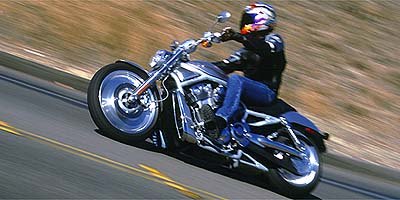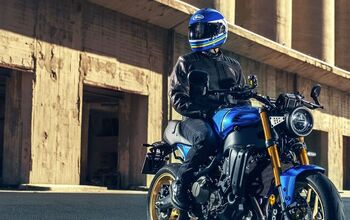Screamin' Eagle V Rod Upgrade - Motorcycle.com
Get the Flash Player to see this player.
After all the magazine covers, TV shows, celebrity endorsements and our own glowing reviews of The Motor Company's new water pumper, it would just be redundant. Even more redundant than this lead has already become, in fact.
We can just tell you that, of all the cruisers we ride, the Rod is the one with the most miles on it. And everywhere we go, people stare at it, even if they don't know what they're staring at. Then the first question pops up: "What does it sound like?" Reluctantly, we thumb the starter button, knowing full well that people expect that traditional potato-potato rumble to fill their ears. We know, too, that we're about to let them down.
Off idle, the bike burbles into a more forceful mid-range and then, as the revs climb towards the limiter, it screams. It turns out the sound of these mufflers at idle is not indicative of what's yet to come as the loud handle gets twisted open. The sound is rather unique, a cross between a more traditional Harley motor and, maybe, and old parallel-twin TT racer.
Performance-wise, the bike felt a bit quicker than it did stock, though the change wasn't overwhelming. Back on the dyno, a few runs revealed an increase of 5 horsepower and 4 foot-pounds of torque. What's most impressive, however, is that these increases didn't come just at peak revs, nor did they come at the expense of power down low in the powerband. A quick glance at the dyno chart reveals that the entire power graph has simply been moved a few horsepower higher, netting an increase in the already broad spread.
A muffler hanger bolt. There are two of them and they're located between the mufflers and the swingarm. You'll likely need a long hex wrench to get at them.Not content with what we had, we looked at the V-Rod on the dyno and noticed the restrictive airbox lid and remembered the custom drag bike Harley had shown us. Specifically, we remembered the louvers on top of the faux gas tank that directed air down into the airbox that resides where the gas tank would normally go.The next dyno pull we did was without any lid on the airbox and without the air filter. Though this wouldn't be a practical choice for real-world riding, we were stationary on a dyno and in lab rat mode, so we thought we'd give it a shot.
The results? Another seven horsepower. But what good was it, really, if you couldn't run it on the street like that? So back on went the Screamin' Eagle air filter and we repeated the run, sans airbox lid, and saw a decrease of only one horsepower from the totally open run we'd just made. Back on went the faux tank lid and the bike rolled off the dyno and onto the street where it remains that way today.
The new air filter before placing the airbox cover back on.Currently, our V-Rod is making 118 horsepower at the rear wheel (up from 107 stock)) and 84 foot-pounds of torque (up from 76 stock) with only a set of Screamin' Eagle mufflers, a high-flow air filter and an EFI re-mapping mixed with a bit of our own ingenuity. The bike now sounds a whole lot better and makes noticeably more power everywhere without suffering from any odd habits. Except for chewing through rear tires at an accelerated rate, of course.After conversing with a representative with Harley-Davidson over our findings, he came back and told us that the Factory did not recommend running the bike without the airbox lid. Something about possible engine damage. Oh well. The lid goes back on then. At least we know that if we did damage the engine that it would've been in the name of journalism!
Parts Used:
65030-02 Screamin' Eagle Slip-Fit Mufflers for VRSC $499.95
29793-02 Screamin' Eagle Performance Air Cleaner $64.95
ECM Calibration (Calibration is Required) $149.95
More by Motorcycle Online Staff

































Comments
Join the conversation